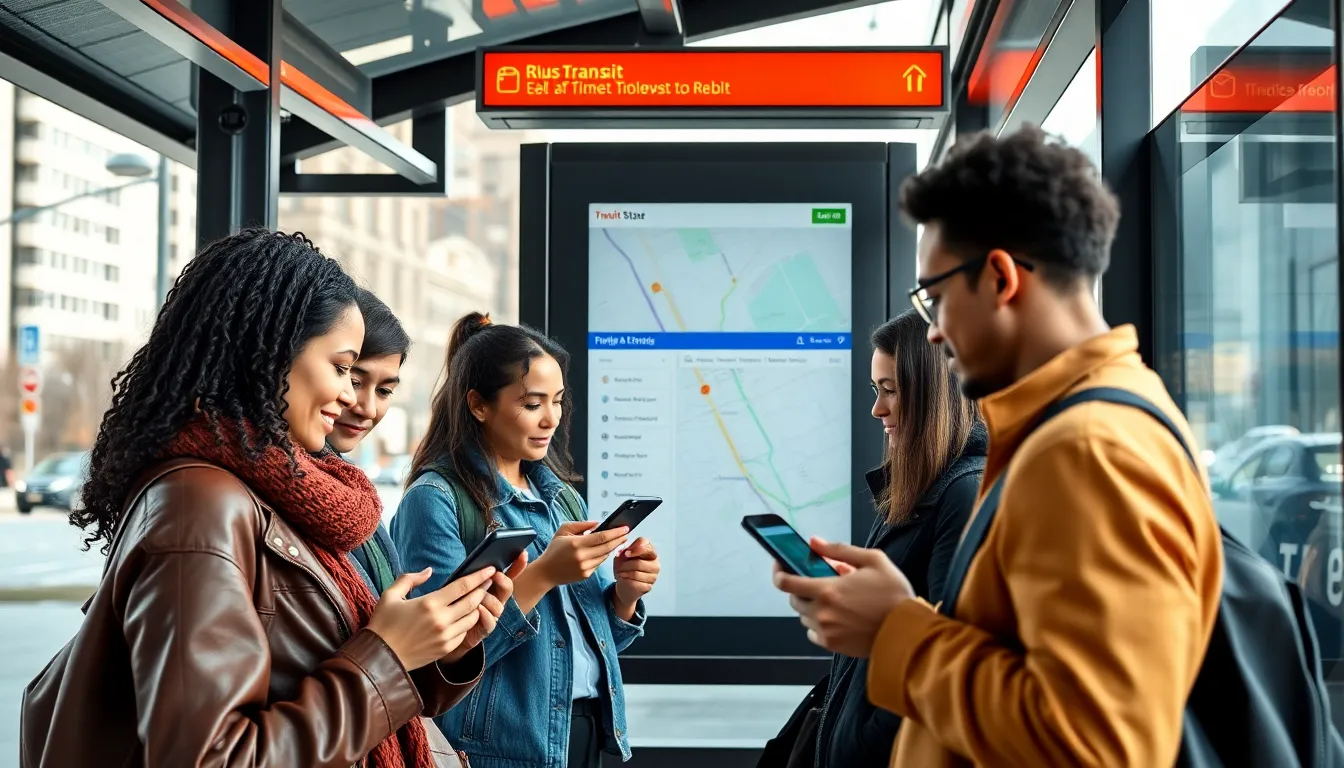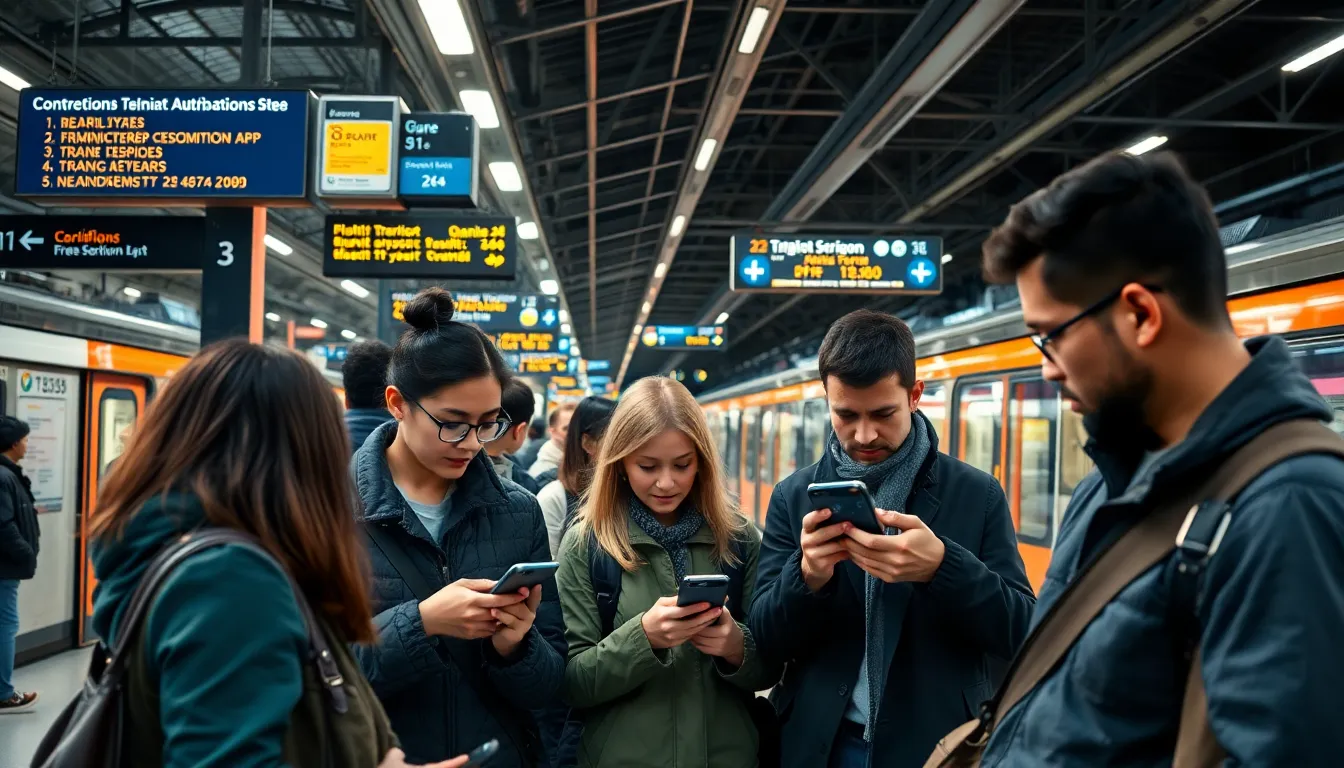Table of Contents
ToggleIn today’s fast-paced world, navigating urban landscapes can be a challenge. Public transit apps have emerged as essential tools for commuters, streamlining the way people access transportation options. These apps not only provide real-time information but also enhance the overall travel experience by offering route planning, schedules, and alerts.
With the rise of smart technology, public transit apps have transformed how individuals interact with their cities. They empower users to make informed decisions about their journeys, whether it’s catching a bus, train, or tram. As cities continue to grow and evolve, these digital solutions play a crucial role in promoting efficient and sustainable transit systems.
Overview of Public Transit Apps
Public transit apps revolutionize urban commuting by integrating various services into a single platform. These applications provide users with real-time transit information, allowing them to plan their journeys efficiently. Key features often include:
- Real-Time Tracking: Users receive up-to-the-minute updates on vehicle locations and expected arrival times.
- Trip Planning: Users can enter their starting point and destination, and the app generates the best route based on current conditions.
- Schedules: Users access comprehensive timetables for different transit modes, including buses, trains, and subways.
- Alerts and Notifications: Users receive alerts for delays, service changes, or emergencies, keeping them informed while on the go.
- Payment Integration: Users can pay for transit fares directly through the app, simplifying the payment process.
Examples of popular public transit apps include Google Maps, Citymapper, and Transit App. These platforms aggregate data from various transit authorities, providing seamless navigation across different modes of transport. As cities grow, public transit apps become essential tools for promoting efficient transit use and reducing congestion.
Key Features of Public Transit Apps

Public transit apps offer essential features that significantly enhance the commuting experience. These functionalities streamline navigation, improve efficiency, and provide users with the information they need to make informed travel decisions.
Real-Time Tracking
Real-time tracking allows users to view the exact location of public transit vehicles. Users benefit from updated information on arrival times, enabling better time management. Apps like Transit App and Citymapper display this data, reducing wait times and uncertainty for commuters. Real-time updates also notify users of unexpected changes in service, enhancing reliability.
Trip Planning
Trip planning features help users navigate complex transit systems. Users can enter their starting point and destination to receive optimized routes using various transit modes. Apps provide step-by-step directions, estimated travel times, and suggest transfers when necessary. These capabilities ensure users avoid delays and select the most convenient options for their journeys.
Mobile Payments
Mobile payment integration simplifies the fare transaction process. Users can securely purchase tickets or passes within the app, eliminating the need for cash or physical cards. Many apps support multiple payment methods, including credit cards and digital wallets. This feature not only streamlines commuting but also enhances user convenience and satisfaction.
Popular Public Transit Apps
Public transit apps play a crucial role in facilitating urban commuting. Here are three popular public transit apps, each with unique features and benefits.
App 1: Google Maps – Features and Benefits
Google Maps provides comprehensive navigation solutions for public transit users. Key features include:
- Real-Time Transit Updates: Users receive live tracking of bus and train arrivals, minimizing wait times.
- Multi-Modal Routes: The app integrates various transportation methods, offering users options like walking, cycling, or rideshares in conjunction with public transit.
- Route Optimization: Google Maps suggests the fastest routes based on current traffic and transit schedules.
- User-Friendly Interface: Its intuitive design makes trip planning straightforward and efficient.
App 2: Citymapper – Features and Benefits
Citymapper excels in delivering an exceptional user experience for urban travelers. Key features include:
- Comprehensive Coverage: The app encompasses multiple cities globally, connecting users with local transit options.
- Live Departure Information: Access to real-time data enhances travel reliability, allowing users to plan accordingly.
- Integrated Payment Systems: Users can purchase transit tickets directly within the app, streamlining fare management.
- Step-by-Step Navigation: Citymapper provides detailed instructions for transit transfers and walking directions for seamless transitions.
App 3: Transit App – Features and Benefits
- Live Arrival Predictions: Users can view imminent vehicle arrivals and receive alerts about service changes.
- Crowdsourced Data: Input from users aids in improving transit accuracy and reliability.
- Customized Notifications: Users receive alerts tailored to their regular routes, keeping them informed of any delays or disruptions.
- User-Centric Design: The app promotes quick access to essential travel information through a streamlined layout and easy-to-navigate menus.
Advantages of Using Public Transit Apps
Public transit apps offer numerous advantages that enhance the overall commuting experience.
- Real-time information. Users access live updates on transit schedules, delays, and vehicle locations, enabling quick decisions about travel plans.
- Route planning capabilities. Users can input their starting points and destinations, receiving optimized routes and travel times, which simplify navigation through complex transit systems.
- Integrated payment systems. Users purchase tickets directly through the app, streamlining fare transactions and reducing the need for physical cash or tickets.
- Multi-modal transit options. Users benefit from options that combine different transportation modes, such as buses, trains, and rideshares, ensuring convenient travel across urban areas.
- Personalized notifications. Users receive alerts for delays, service changes, and upcoming departures, fostering awareness and preparedness during their daily commute.
- Accessibility features. Users find services designed to assist individuals with disabilities, ensuring equitable access to public transit systems.
These advantages highlight how public transit apps play a critical role in making commuting more efficient and user-friendly.
Challenges and Limitations
Public transit apps face several challenges and limitations that can hinder user experience and effectiveness.
- Data Accuracy: Public transit apps rely on data from transit authorities. Inaccurate or outdated information can lead to user frustration. Delays in data updates can cause confusion regarding arrival times and route changes.
- Coverage Gaps: Some apps lack comprehensive coverage in certain areas. They may not include all transit options or services, limiting users’ travel choices in less populated regions.
- Connectivity Issues: Users often experience connectivity problems, especially in underground or rural areas. When GPS or internet access fails, app functionalities become severely limited, affecting trip planning and real-time updates.
- User Interface Complexity: Some apps feature complex interfaces that can overwhelm users. Complicated menus and navigation may deter new users from effectively utilizing the app’s features.
- Battery and Data Consumption: Continuous use of public transit apps consumes device battery and mobile data. Users with limited resources may face challenges in staying connected while relying on these services.
- Integration Limitations: While many apps aim to provide multi-modal travel options, integration with other systems may not always be seamless. Users may find it difficult to switch between different modes of transportation without clear guidance.
- Privacy Concerns: Collecting user data raises privacy issues. Users may hesitate to share information, affecting personalized features that enhance the commuting experience.
- Prominence of Other Options: Popularity of ride-sharing services can overshadow public transit apps. Users may prefer private options due to perceived convenience, limiting app engagement.
Understanding these challenges is crucial for improving public transit app development and adoption, ensuring they better serve urban commuters.
Public transit apps are reshaping urban commuting by offering essential tools that enhance travel efficiency and convenience. As more people rely on these digital solutions to navigate their cities, the importance of real-time information and integrated services becomes increasingly evident.
The ongoing development of these apps promises to address existing challenges while continuously improving user experience. With features designed to simplify transit use and promote sustainable travel options, public transit apps are set to play a pivotal role in the future of urban mobility. Embracing these technologies will enable commuters to make smarter choices and contribute to more efficient transit systems.




